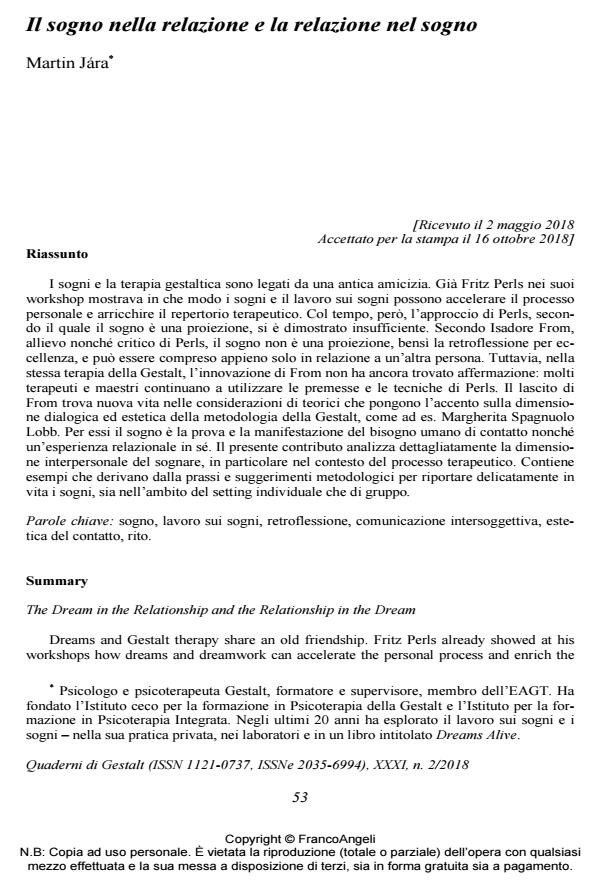The Dream in the Relationship and the Relationship in the Dream
Journal title QUADERNI DI GESTALT
Author/s Martin Jára
Publishing Year 2018 Issue 2018/2
Language Italian Pages 13 P. 53-65 File size 163 KB
DOI 10.3280/GEST2018-002008
DOI is like a bar code for intellectual property: to have more infomation
click here
Below, you can see the article first page
If you want to buy this article in PDF format, you can do it, following the instructions to buy download credits

FrancoAngeli is member of Publishers International Linking Association, Inc (PILA), a not-for-profit association which run the CrossRef service enabling links to and from online scholarly content.
Dreams and Gestalt therapy share an old friendship. Fritz Perls already showed at his workshops how dreams and dreamwork can accelerate the personal process and enrich the therapist’s range of techniques. Over time, however, Perls’s approach, according to which dreams are an intrapsychic projection, proved to be insufficient. In the view of Perls’s student and critic Isadore From, dreams are not a projection but a retroflection par excellence, and they can be fully understood only in relation to another person. Nevertheless, From’s innovation has not yet taken root in Gestalt therapy, and many therapists and teachers continue to work with Perls’s techniques and presuppositions. Today, From’s legacy is being revived by theorists, such as Margherita Spagnuolo Lobb, who are emphasizing the dialogic and aesthetic dimensions of Gestalt. For them, dreams are evidence and an expression of the human need for contact and relational experience per se. The paper first takes a look back at the changing understanding of dreams within Gestalt therapy, and then explores in detail the interpersonal dimension of dreaming, in particular within the context of the therapeutic process - including practical examples and methodological tips for how to sensitively bring dreams to life in both a individual and group setting.
Keywords: Dream, dreamwork, retroflection, intersubjective communication, easthetics of contact group, ritual.
- Amendt-Lyon N. (2007). Momenti memorabili nella relazione terapeutica. In: Spagnuolo Lobb M., Amendt-Lyon N., a cura di, Il permesso di creare. L’arte della psicoterapia della Gestalt. Milano: FrancoAngeli, pp. 275-291 (ed. or.: Creative License. The Art of Gestalt Therapy. Wien, New York: Springer, 2003).
- Crispino S. e Merlo G. (2014). Tu mi sogni, io ti sogno: I sogni al confine di contatto nel setting psicoterapici gestaltici. In: Francesetti G., Ammirata M., Riccamboni S., Sgadari N., Spagnuolo Lobb M., a cura di, Il dolore e la bellezza. Atti del III Convegno della Società Italiana di Psicoterapia della Gestalt. Milano: FrancoAngeli, pp. 125-134.
- Hesse H. (2011). Poesie d’amore. Milano: Arnoldo Mondadori.
- Higgins J. (1994). Honouring the Dream. An Interview with Dolores Bate. The British Gestalt Journal, 3, 2: 117-124.
- From I. (1978). An Oral History of Gestalt Therapy, part. 2: A Conversation with Isadore From (conducted by Edward Rosenfeld). The Gestalt Journal, 1, 2: 8-27.
- Larsen S. (1998). The Shaman’s Doorway: Opening Imagination to Power and Myth. Rochester VT: Inner Traditions International.
- Moore T. (1997). The Re-Enchantment of Everyday Life. London: HarperPerennial.
- Neri C., Pines M. e Friedman R., a cura di (2005). I sogni nella psicoterapia di gruppo. Roma: Borla (ed. or.: Dreams in Group Psychotherapy. London & Philadelphia: Jessica Kingsley Publishers, 2002).
- Perls F. (1980). La terapia gestaltica parola per parola. Roma: Astrolabio (ed. or: Gestalt Therapy Verbatim. Moab, UT: Real People Press, 1969).
- Perls F. (1995). L’Io, la fame, l’aggressività, Milano: FrancoAngeli (ed. or.: Ego, Hunger and Aggression: A Revision of Freud’s Theory and Method. London: G. Allen&Unwin, 1947; New York, NY: Random House, 1969).
- Perls F.S., Hefferline R.F. e Goodman P. (1997). Teoria e pratica della terapia della Gestalt. Vitalità e accrescimento nella personalità umana. Roma: Astrolabio (ed. or.: Gestalt Therapy. Excitement and Growth in the Human Personality. New York, NY: The Gestalt Journal Press, 1951; 1995).
- Polster E. e Polster M. (1986). Terapia della Gestalt integrata. Profili di teoria e pratica. Milano: Giuffrè (ed. or.: Gestalt Therapy Integrated. Contours of Theory and Practice. New York, NY: Brunner-Mazel, 1973).
- Spagnuolo Lobb M. (2009). Il setting dal punto di vista della psicoterapia della Gestalt. La co-creazione dell’esperienza terapeutica nel qui-e-ora. In: Loriedo C., Acri F., a cura di, Il setting in psicoterapia. Lo scenario dell’incontro terapeutico nei differenti modelli clinici di intervento. Milano: FrancoAngeli.
- Spagnuolo Lobb M. (2011). Il now-for-next in psicoterapia. La psicoterapia della Gestalt raccontata nella società post-moderna. Milano: FrancoAngeli.
- Spagnuolo Lobb M. (2017). La conoscenza relazionale estetica del campo. Per uno sviluppo del concetto di consapevolezza in psicoterapia della Gestalt e nella clinica contemporanea. Quaderni di Gestalt, XXX, 1: 17-33. DOI: 10.3280/GEST2017-001003
- Yalom I.D., Leszcz M. (2009). Teoria e pratica della psicoterapia di gruppo. Torino: Bollati Boringhieri (ed. or.: The Theory and Practise of Group Psychotherapy. 5th ed. New York: Basic Books, 2005).
- Wheeler G. (1991). Gestalt Reconsidered: a New Approach to Contact and Resistance. New York, NY: Gardner Press.
- Zinker J. (2010). Processi creativi in psicoterapia della Gestalt. Milano: FrancoAngeli (ed. or.: Creative Process in Gestalt Therapy. New York, NY: Vintage Books, 1978).
Martin Jára, Il sogno nella relazione e la relazione nel sogno in "QUADERNI DI GESTALT" 2/2018, pp 53-65, DOI: 10.3280/GEST2018-002008